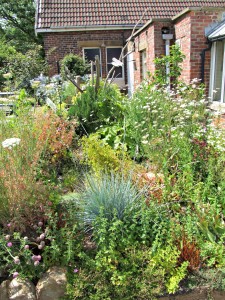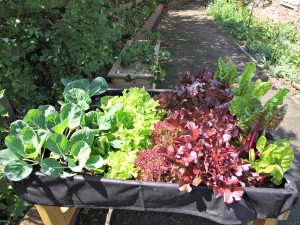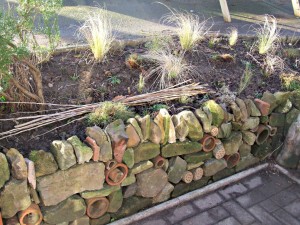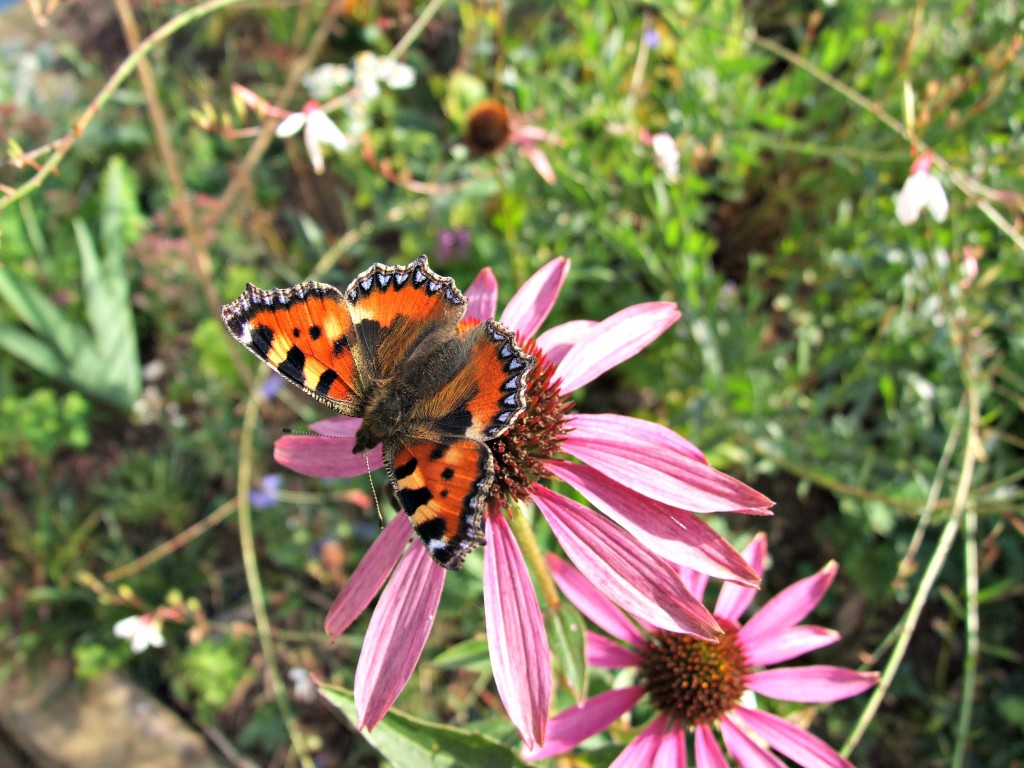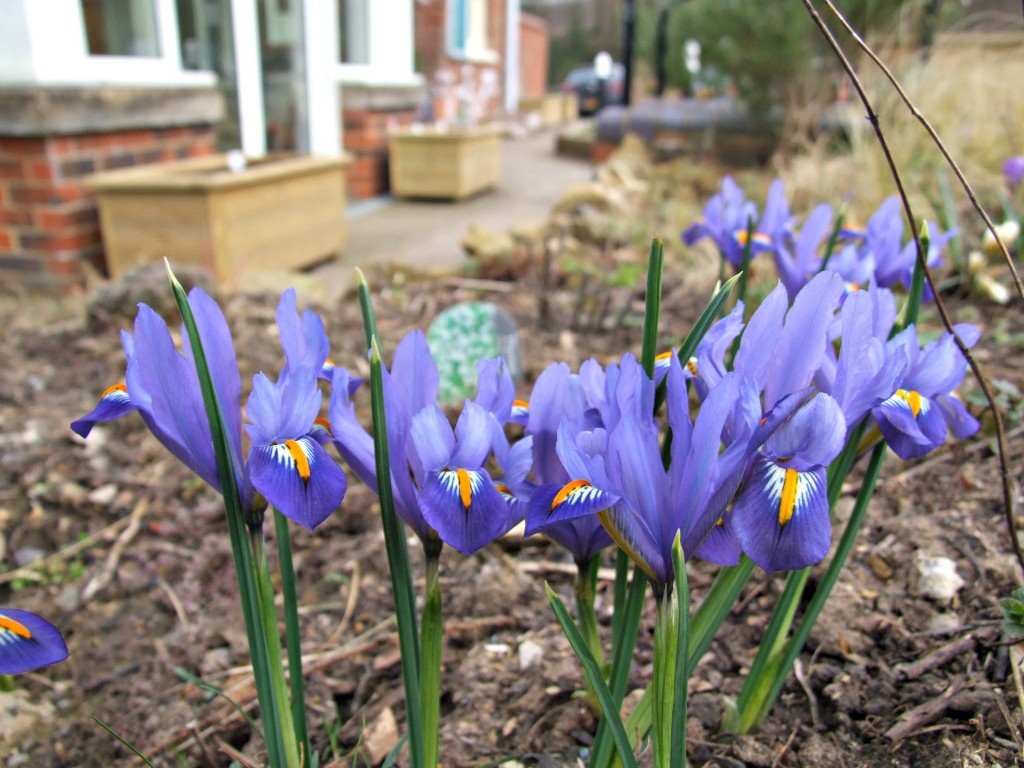As part of the Growing Food for the Future Project the Trust working with Martin Allen decided to completely revamp the schools garden here at Margrove Heritage Centre. The brief given to Martin was to create to create an edible and wildlife garden packed full with inspiration on new, easy ways to grow fruit and vegetables, as well as a number of learning opportunities for the schools that visit.
He took on the challenge and with the help of Trust staff especially Amy Carrick and volunteers a splendid multifunctional garden was created. You can see the story behind the garden here.
The garden is divided into several sections all with a mixture of plants many edible and wildlife friendly.
The vegetables are all grown in large tubs so that they are easier to look after; not too much weeding and only a spot of watering required if it gets hot and dry in the summer. When the garden was first put in we used to get the vegetables as plug plants from Rocket gardens – all we had to do is pop them in the soil and then pick them when they are ready to eat.
Martin continues the story of the garden
“The fruit we’ve put in the garden just like you would use normal garden plants…no boring rows for us. There’s a small apple tree by the pond (next to the rhubarb) and a larger crab-apple with gorgeous white flowers to help with cross-pollination so we get a good crop. We’ve grown lots of nectar-rich flowers in the borders to encourage bees and insects to visit our apples and other fruit bushes like gooseberries, raspberries, and blackcurrants. The only exception to planting in our heavy soil here are the blueberries, and you can see them in special acid soil in tubs by the front door.
We’re trying some unusual things too; over in the far corner is a gage tree (a sort-of green plum) and nearby is an oregon grape which has edible berries (apparently). One of the two hazel bushes has been impregnated with truffle spores – fingers crossed that works, there’s a rose grown for the hips to use in syrup and while we’re thinking of making drinks there’s a dark-leaved Elder nearby…pink elderflower champagne anyone? Oh, and some of the raspberries are actually meant to be yellow (they’re very tasty too).
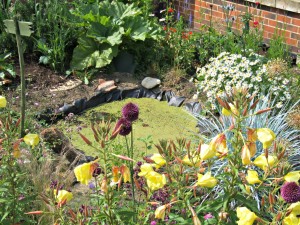 And did you know you can eat violet flowers? Well we’re growing them next to our globe artichoke, another flower you can eat, and near the chives and garlic chives – all edible. There’s one plant of asparagus and the shoots of hostas are a great delicacy in Japan – that’s if the slugs and snails don’t get there first. Talking of which, we like the snails and the slugs and have lots of places for them and the mini-beasts to hide, from composted bark and logs to our fantastic urban stone walls and the big smooth shiny elephant ears plant (bergenia) where the snails love to cluster together.”
And did you know you can eat violet flowers? Well we’re growing them next to our globe artichoke, another flower you can eat, and near the chives and garlic chives – all edible. There’s one plant of asparagus and the shoots of hostas are a great delicacy in Japan – that’s if the slugs and snails don’t get there first. Talking of which, we like the snails and the slugs and have lots of places for them and the mini-beasts to hide, from composted bark and logs to our fantastic urban stone walls and the big smooth shiny elephant ears plant (bergenia) where the snails love to cluster together.”
The garden has been designed not just for us to eat from but also for all the local wildlife and as an educational resource. It has 2 innovative features: a rustic bird cafe and a habitat wall. The rustic bird cafe is designed as a bird table “plus” by Keith Ferry from Woodland Connections – it has lots of nooks and crannies for invertebrates to hide or occasionally get eaten! It has a flat table for bird food as well as places to hang feeders on. It also has number of plant growing up it. Around the garden we also have an assortment of bird boxes and insect boxes and a hedgehog box. The habitat wall is designed to provide a home for a variety of invertebrates with a multitude of spaces of different sizes for them to hide.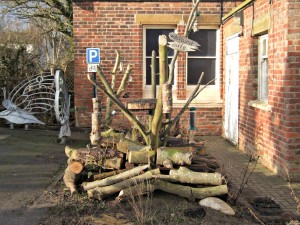
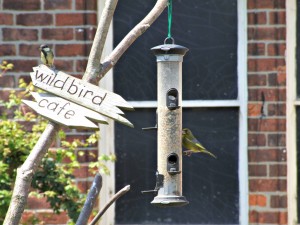
The birds hang out at our bird cafe, have a drink at the pond and can get nesting material from the ornamental grasses. We provide a mixture of bird food bought from Vine Farm including a mixed seed to attract a host of birds including Blue and Great Tits, Robin and Dunnock and Greenfinch Niger seed for the Goldfinches, and peanuts for Greater Spotted Woodpecker. This year we were treated to a family with 3 young woodpeckers all with their resplendent red caps.
However, not all our flowers are perfect for pollinators; some are double with very little pollen. Why? Well we get lots of school visits and if we want to do an experiment to see what’s best for the bees we need single flowers and double flowers to compare.
A well used part of the garden especially for making smell tea or smelly cocktails is the mint bed with Chocolate Mint, Apple Mint, Garden Mint and Spearmint.
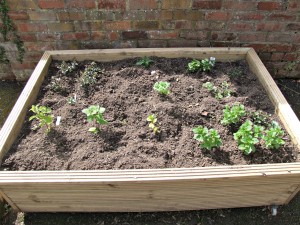
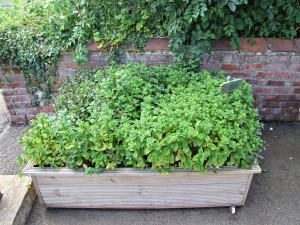
In 2014 the garden won the “Best Community Innovative Garden Award” in the Birdwatching Magazine’s wildlife gardening competition, the prize was £500 worth of even more enhancements for the garden more mini-beast hotels, feeders and more plants!
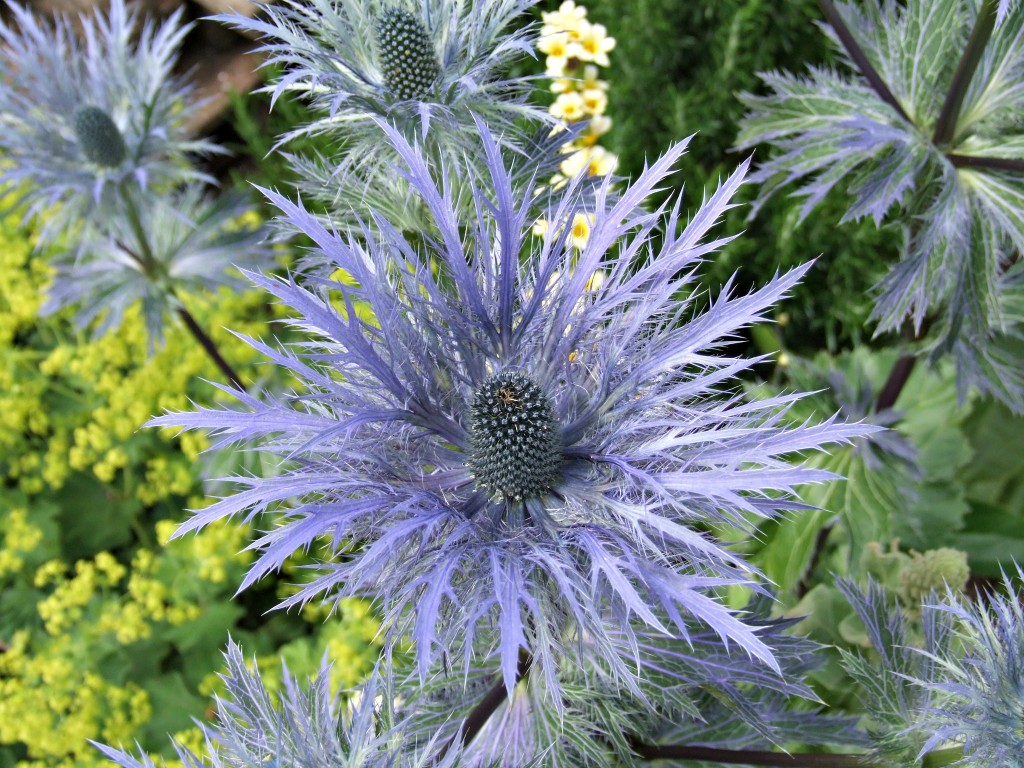
The garden is visited by over 1500 pupils a year and it is hoped that they will take away ideas from the garden to try at home. You can find more information about wildlife gardening here.
A plant list can be downloaded from here. Plant list
After nearly 2 years the garden has started mature and livened up many a staff meeting as a Greater Spotted Woodpecker arrives on a feeder. It’s now managed by volunteer garden Arthur and our vegetables are being tended to by the Saltburn Garden group who are lodging with us at the moment.

